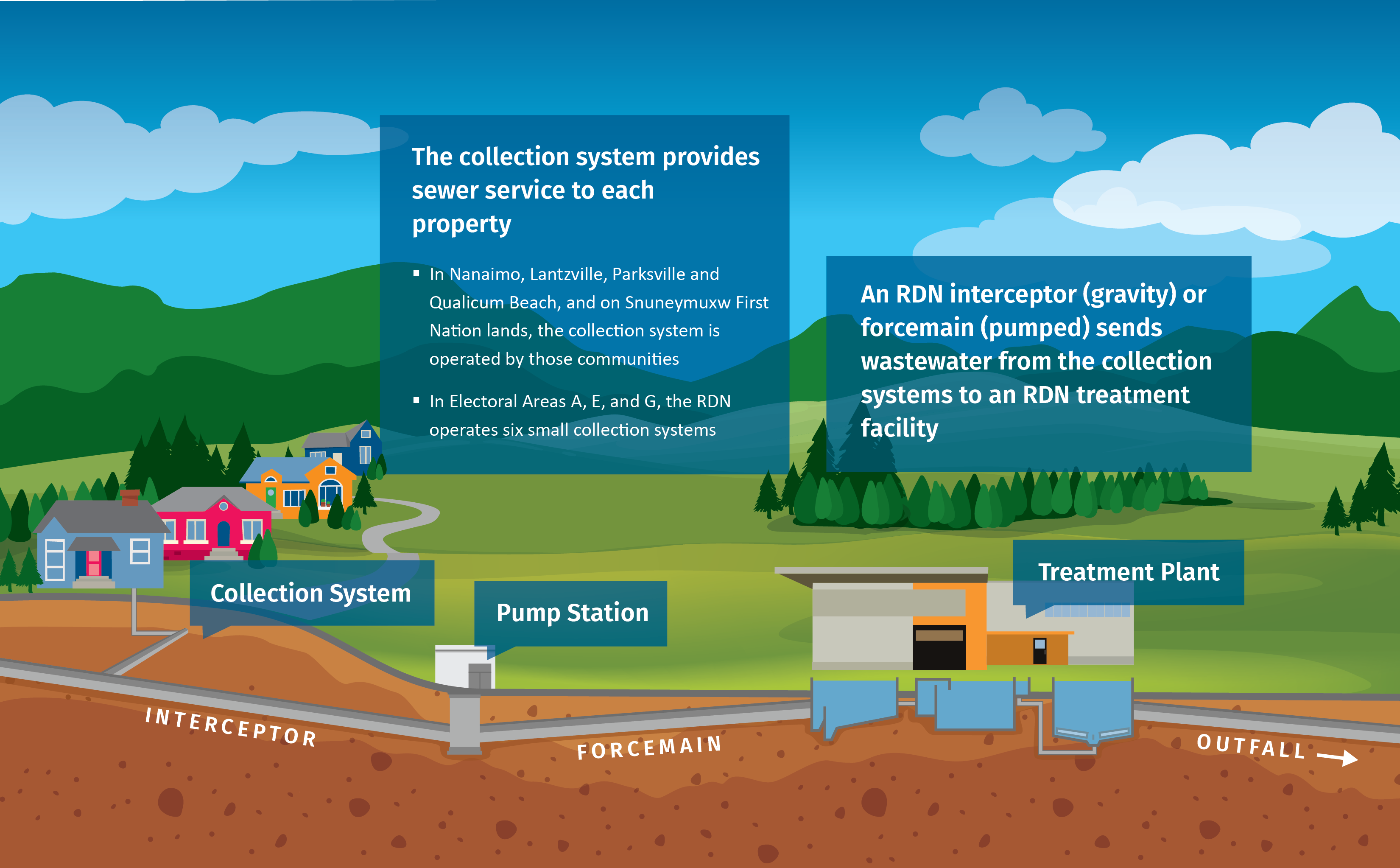How Treatment Works
Wastewater treatment is essential to protect our water resources, the environment and human health. Wastewater refers to ‘used’ water or anything that is flushed down the toilet or washed down the drain.
Collection System
To begin treatment, wastewater from households and businesses must travel to a treatment facility. . First, the collection system moves wastewater through an interceptor to the pump station. In Nanaimo, Lantzville, Parksville and Qualicum Beach, as well as on Snuneymuxw First Nation Lands, the collection system is operated by those communities. In Electoral Areas A, E and G, the Regional District of Nanaimo operates six small collection systems. Sewers are built to follow the natural slope of land, allowing gravity to do most of the work to transport wastewater. Low elevation areas use a pump station to pump the wastewater to a treatment plant through a forcemain.

Types of Treatment
The RDN owns and operates four wastewater treatment facilities, providing different types of treatment:
-
Greater Nanaimo Pollution Control Centre (GNPCC) provides secondary treatment
-
French Creek Pollution Control Centre (FCPCC) provides secondary treatment
-
Nanoose Bay Pollution Control Centre (NBPCC) provides chemically enhanced primary treatment
-
Duke Point Pollution Control Centre (DPPCC) provides secondary treatment with UV disinfection
Preliminary Treatment
Wastewater entering the treatment plant first passes through screens and grit tanks. The screens remove rags, wipes, sticks, plastic and larger objects. Grit tanks settle out heavy particles like sand and stones. The screenings and grit are transported to the Regional Landfill for disposal.
Primary Treatment
After preliminary treatment, wastewater flows into a primary settling tank where it is held for several hours. Time and gravity allow solid particles to settle to the bottom of the tank. The settled solids, known as primary sludge, are collected and pumped to a digester for further treatment into reusable biosolids.
Fats, oil and grease that float to the top of tanks, are skimmed off, dried, and sent to the landfill. Chemically enhanced Primary Treatment adds clumping compounds (a coagulant and flocculant) to enhance the settling of solids.
Primary treatment removes about half of the Biological Oxygen Demand (BOD) and 60-70% of Total Suspended Solids (TSS), to produce effluent with a BOD and TSS not exceeding 130 mg/L.
Secondary Treatment
Following primary treatment, effluent is pumped to the secondary treatment stage where it is aerated and biologically treated. The growth of micro-organisms results from the consumption of organic matter in the wastewater as their food supply.
The micro-organisms create a solid organic material called secondary sludge. Secondary sludge is thickened, pumped to digesters and converted into reusable biosolids. Water is removed from the biosolids, surplus water from the dewatering process is returned to the headworks.
Secondary treatment is a biological treatment process that removes more than 90 percent of BOD and TSS and produces an effluent quality with BOD and TSS not exceeding 45 mg/L. Tertiary Treatment.
Also known as advanced treatment, tertiary can use chemical, physical or biological treatment processes to remove wastewater constituents that cannot be removed by secondary treatment. Tertiary treatment can produce phosphorus levels less than 1.0 mg/L, BOD and TSS levels less than 5 mg/L, and low nitrogen levels.
Tertiary treatment is often used when there is discharge to lakes or rivers and the phosphorus levels need to be significantly reduced, or if there is a desire to reclaim effluent. Currently, no treatment facilities in the RDN use tertiary treatment.
Frequently Asked Questions
What is biochemical oxygen demand (BOD) and total suspended solids (TSS)?
Biochemical Oxygen Demand (BOD) is a measure of the quantity of oxygen consumed by microorganisms to break down organic matter in water. A high BOD means that there will be less oxygen available to aquatic life.
Total Suspended Solids (TSS) are solid pollutants that would be captured on fine filter paper. They are visible in water and decrease water clarity. High concentrations of TSS can cause problems for aquatic life.
How are biosolids produced?
During the treatment process, sludge (organic and inorganic materials that settle in a primary clarifier or secondary clarifier) is sent to digesters for solids processing. In the digesters, the sludge is digested by micro-organisms using the organic material present in the solids as a food source and converting it to by-products such as methane gas and water. Digestion reduces pathogens by more than 98%. Mechanical equipment is used to remove water from the biosolids, producing the final dewatered soil-like product. Learn more about Biosolids
How does household water consumption affect wastewater?
The majority of wastewater in the RDN comes from residential water use. By conserving water at home, we produce less wastewater and can reduce the cost of treatment.
How does the RDN manage odours from the wastewater treatment process?
For more information on RDN Odour Control program, visit the Odour Control page.
How do I know if I'm on sewer?
If you benefit from sewer services, your property tax and/or utility bill will include a charge for this service. Most people living within Nanaimo, Lantzville, Parksville, Qualicum Beach and French Creek receive sewer services. However, some properties within municipal boundaries have a private onsite (septic) system and some people in the Electoral Areas have sewer. Search your address on the RDN Utilities Map
What laws regulate municipal wastewater treatment?
Municipal wastewater treatment is governed by the provincial Municipal Wastewater Regulation and federal Wastewater Systems Effluent Regulations. These regulations include mandatory minimum effluent quality standards that can be achieved through secondary wastewater treatment or better. They also include requirements for monitoring, record-keeping, reporting and toxicity testing.